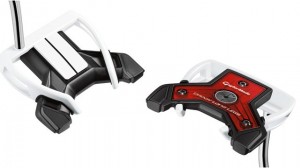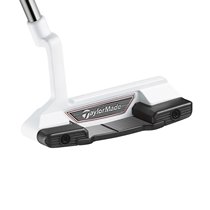Until the USGA makes a final determination whether to implement the proposed ban of anchored putting strokes, the debate over the use of nonstandard length putters continues. What only a few people are talking about though is viable alternative should the Rules of Golf be written to forbid use of long putters by pivoting the butt end against some body part.
The alternative is using a putter with extra weight near the end of the grip or so-called counterbalance weighting. This configuration accomplishes two things. It smoothes out the putting stroke plus the weighting aids the user with his “putting touch,” or feel for distance.
The smoother stroke is implicit when using an anchored stroke, either with a belly or broomstick length putter. Therefore being able to achieve virtually the same benefit with a putter of shorter length through counterbalance weighting is a major plus. The other negative reported by non-standard length putter users has always been the loss of feel for distance especially on long putts and in fact is a big reason why many trying long putters don’t stay with them. Putters with high modulus of inertia (MOI) which is the resistance to twisting are ideal for developing a putting touch.
All of this brings us to TaylorMade Golf’s latest introductions to their “arachnid models” or Spider line of putters, the Daddy Long Legs and Spider Blade. Both are counterbalanced with more weight in the grip-end and have very high MOI values.
“The higher the head’s MOI, the more resistant it is to twisting on off-center hits, helping you roll the ball your desired distance, and on your desired line, on miss hits,” said Brian Bazzel, product category director for putters and wedges. “The exceptionally high MOI of the Daddy Long Legs and Spider Blade heads makes them a terrific choice for golfers seeking forgiveness in a putter.”
To counterbalance a putter, a much heavier grip is used to balance the weight of the clubhead and this changes how the putter behaves. The heavier grip also dramatically increases the resistance to twisting of the entire club. It’s easier to keep the head on path and makes it 60% more stable than a traditional putter according to TMaG.
“In addition to increasing the MOI of our putterheads, we started researching ways to keep the head from wavering from the intended swing path during the stroke–a primary cause of missed putts,” said Bazzel. “We recognized that if we could make it easier to swing the putterhead on-path, we could help players roll the ball down their intended line. Counterbalance helps solve that problem.”
Purchasing a counterbalanced putter requires a bit different thinking for a proper fit. For the counterbalancing to be most efficient about three inches of the top end of the grip should extend above your top hand. To make that possible the Daddy Long Legs and Spider Blade are offered in two lengths: 38”, for players who favor a 35” length and 35” for players who favor a 33” length. Players normally using a 34” length can choose either.
The Spider Blade, available in June, is a heel-toe weighted blade that has an astounding 5200 MOI – the most in any TMaG blade while the Daddy Long Legs’ MOI TMaG says measures over 8500. Comparable MOI measurements for previous Spider putters are Spider/Ghost Spider 6800, Ghost Spider S 6038 and Itsy Bitsy Spider 5375.
The Daddy Long Legs head is made of 16 pieces of eight different materials – stainless steel, carbon steel, aluminum, titanium, tungsten, polycarbonate, Surlyn and TPU. Spider Blade’s head construction consists of 11 parts made of eight materials — 304 stainless steel, 17-4 stainless steel, aluminum, 3M Foam, tungsten, polycarbonate, Surlyn and TPU.
Both the Daddy Long Legs and Spider Blade putters are priced at $199 and offered in a single bend 35” or 38” shaft. Daddy Long Legs is available now; retail availability for the Spider Blade begins June 1.


